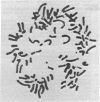Abstract
Long-term monolayer cell cultures have been prepared from tumor nodules in spleens removed from 28 patients with Hodgkin's disease and from 84 spleens that did not have tumors from Hodgkin's disease patients, normal adult spleens, and human fetal spleens and thymuses. After 5 to 20 serial passages in culture, cells from nine of the Hodgkin's disease monolayers underwent morphologic change in vitro with transition from a spindle and reticular pattern of replication to polygonal and round cells that propagated in mosaic arrays. Four of such Hodgkin's disease monolayer cell lines were injected subcutaneously into 43 nude, athymic mice. In 36 animals (84%), neoplasms developed at the inoculation site that werel ocally destructive, capable of pulmonary metastasis, and eventually fatal to the recipients. Transplanted tumors were not observed in 18 athymic mice injected with cultures prepared from normal human adult spleen and fetal spleen and thymus, nor were tumors seen in 16 similar animals that received fresh, noncultured Hodgkin's disease tumor tissue. On microscopic examination, xenografts derived from Hodgkin's disease cultures were pleomorphic malignant neoplasms composed of large, undifferentiated cells, resembling reticulum cell sarcoma. These neoplasms did not involve the lymphoreticular organs of mice. Chromosome studies indicated that the transplanted neoplasms were composed of human cells with an aneuploid karyotype and that monolayer cultures prepared from the heterotransplants contained a karyotype similar to that of the cultured cells prior to passage in mice. The ability of these Hodgkin's disease cell lines to produce invasive tumors with human karyotypes in nude mice is evidence of the neoplastic nature of the monolayer cells and their relationship to the malignant cell of the human disorder.
Full text
PDF




Images in this article
Selected References
These references are in PubMed. This may not be the complete list of references from this article.
- Adams R. A., Foley G. E., Farber S., Hellerstein E. E., Pothier L. The oncogenicity of cell cultures isolated from normal subjects and from patients with infectious mononucleosis, Letterer-Siwe disease or Hodgkin disease. Birth Defects Orig Artic Ser. 1973 Jan;9(1):200–211. [PubMed] [Google Scholar]
- Adams R. A., Hellerstein E. E., Pothier L., Foley G. E., Lazarus H., Stuart A. B. Malignant potential of a cell line isolated from the peripheral blood in infectious mononucleosis. Cancer. 1971 Mar;27(3):651–658. doi: 10.1002/1097-0142(197103)27:3<651::aid-cncr2820270321>3.0.co;2-b. [DOI] [PubMed] [Google Scholar]
- Epstein A. L., Herman M. M., Kim H., Dorfman R. F., Kaplan H. S. Biology of the human malignant lymphomas. III. Intracranial heterotransplantation in the nude, athymic mouse. Cancer. 1976 May;37(5):2158–2176. doi: 10.1002/1097-0142(197605)37:5<2158::aid-cncr2820370503>3.0.co;2-f. [DOI] [PubMed] [Google Scholar]
- Epstein A. L., Kaplan H. S. Biology of the human malignant lymphomas. I. Establishment in continuous cell culture and heterotransplantation of diffuse histiocytic lymphomas. Cancer. 1974 Dec;34(6):1851–1872. doi: 10.1002/1097-0142(197412)34:6<1851::aid-cncr2820340602>3.0.co;2-4. [DOI] [PubMed] [Google Scholar]
- Foley G. E. Neoplastic properties of animal cell lines. Methods for determining neoplastic properties. Natl Cancer Inst Monogr. 1968 Dec;29:217–228. [PubMed] [Google Scholar]
- Gershwin M. E., Merchant B., Gelfand M. C., Vickers J., Steinberg A. D., Hansen C. T. The natural history and immunopathology of outbred athymic (nude) mice. Clin Immunol Immunopathol. 1975 Sep;4(3):324–340. doi: 10.1016/0090-1229(75)90002-1. [DOI] [PubMed] [Google Scholar]
- Giovanella B. C., Stehlin J. S., Williams L. J., Jr Heterotransplantation of human malignant tumors in "nude" thymusless mice. II. Malignant tumors induced by injection of cell cultures derived from human solid tumors. J Natl Cancer Inst. 1974 Mar;52(3):921–930. doi: 10.1093/jnci/52.3.921. [DOI] [PubMed] [Google Scholar]
- Long J. C., Aisenberg A. C., Zamecnik P. C. An antigen in Hodgkin's disease tissue cultures: fluorescent antibody studies. Proc Natl Acad Sci U S A. 1974 Jun;71(6):2285–2289. doi: 10.1073/pnas.71.6.2285. [DOI] [PMC free article] [PubMed] [Google Scholar]
- Long J. C., Aisenberg A. C., Zamecnik P. C. An antigen in Hodgkin's disease tissue cultures: radioiodine-labeled antibody studies. Proc Natl Acad Sci U S A. 1974 Jul;71(7):2605–2609. doi: 10.1073/pnas.71.7.2605. [DOI] [PMC free article] [PubMed] [Google Scholar]
- MOORHEAD P. S., NOWELL P. C., MELLMAN W. J., BATTIPS D. M., HUNGERFORD D. A. Chromosome preparations of leukocytes cultured from human peripheral blood. Exp Cell Res. 1960 Sep;20:613–616. doi: 10.1016/0014-4827(60)90138-5. [DOI] [PubMed] [Google Scholar]
- Maguire H., Jr, Outzen H. C., Custer R. P., Prehn R. T. Invasion and metastasis of a xenogeneic tumor in nude mice. J Natl Cancer Inst. 1976 Aug;57(2):439–442. doi: 10.1093/jnci/57.2.439. [DOI] [PubMed] [Google Scholar]
- Povlsen C. O., Fialkow P. J., Klein E., Klein G., Rygaard J., Wiener F. Growth and antigenic properties of a biopsy-derived Burkitt's lymphoma in thymus-less (nude) mice. Int J Cancer. 1973 Jan 15;11(1):30–39. doi: 10.1002/ijc.2910110105. [DOI] [PubMed] [Google Scholar]








